Introductory Theory
1. Enhancing Energy Levels
It’s all about energy levels.
In the game of life, our energy levels shape everything.
When energy is low, we feel lethargic, unmotivated, and stuck in negative thought patterns. We become more reactive, easily irritated, and prone to unproductive habits. This not only hinders our performance but also strains our relationships, as our low energy affects those around us.
On the other hand, when we are brimming with energy, our entire outlook changes. We radiate positivity and enthusiasm, which can be contagious. We are more likely to make jokes, laugh, and enjoy the present moment. High energy levels enhance our cognitive functions, allowing our brain to work faster and more efficiently. This mental sharpness helps us recognise and break free from our habitual, often unhelpful, patterns of behaviour. With ample energy, we become less reactive and more thoughtful in our responses. We are more likely to consider other perspectives and interpretations, which fosters empathy and understanding. This heightened awareness and charitable mindset lead to better, more harmonious relationships. Our actions become more deliberate and conducive to positive interactions, creating a ripple effect of goodwill and cooperation.
Energy also directly impacts our physical health. Low energy weakens the immune system, disrupts hormones, and slows digestion, increasing the risk of illness and chronic conditions. Fatigue leads to inactivity, which can contribute to weight gain and other health concerns.
Conversely, abundant energy strengthens immunity, enhances cognitive function, and supports overall wellbeing. It fuels our body, mind, and emotions—shaping our experiences and interactions.

In other words, our energy levels play a crucial role in determining our physical, mental, emotional and social health.
The key understanding here is that our energy levels are within our control.
While many aspects of our lives can feel beyond our influence, our energy levels are determined by the choices we make and the habits we cultivate. This means we always have the power to enhance and manage our energy (with all of the flow-through benefits in all the aspects of our life) through intentional actions.
By managing our energy, we influence every aspect of our lives for the better.
How do we make sure that we maintain and improve our energy levels, every day?
There are many aspects to this.
The first is to become aware of, and plug up, leaks of energy. We leak energy in many ways. One of the main ones is worrying what other people think about us – that’s a devastating leak that can be constant all day. Another major energy drain is engaging in negative self-talk or harbouring self-doubt. These mental habits can consume significant amounts of our energy without us even realising it.
Other leaks of energy are:
- Unresolved conflicts: ongoing disagreements and unresolved issues in relationships can cause mental and emotional strain, sapping our energy.
- Overthinking: Excessive worrying and overanalysing situations consume a lot of mental energy, leaving us feeling drained.
- Lack of purpose: Feeling unmotivated or lacking a sense of purpose can make us feel drained and unfulfilled, affecting our energy and enthusiasm.
- Unfulfilled commitments: Having too many obligations or not following through on commitments can create mental stress and drain our energy.
- Poor diet: if we eat foods that are not suited to our constitution, it requires a great deal more energy for our bodies to process it compared to when we eat the rights foods for our constitution.
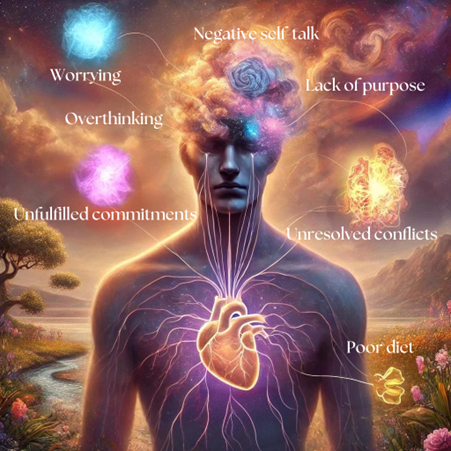
So, the first step in having more energy is to find and put an end to the leaks of energy that we may be carrying.
The next step is do things that increase energy.
The main way to increase energy is to have fun, whatever that means for you as an individual. Indeed, the very meaning of the word “fun” is something that increases our energy – the two concepts are intricately interlinked. Engaging in activities that bring joy and fulfillment have a profound impact on our energy levels.
Other ways to increase energy are:
- Physical activity: Regular exercise, whether it’s a brisk walk, a dance class, or a workout at the gym, can significantly boost your energy. Physical activity increases blood flow and oxygen to your brain and muscles, making you feel more energised and alert.
- Hobbies and recreational activities: Engaging in hobbies or activities that you are passionate about are a great way to recharge. Whether it’s painting, gardening, playing a musical instrument, or reading, doing what you love invigorates your mind and body. This is actually all about the power of fun – it is our hobbies that lead us to the joy and fulfillment that energise our spirits. Through these enjoyable pursuits, we tap into a source of positive energy that refreshes us and enhances our overall wellbeing.
- Social connections: Positive social interactions lift our spirits and provide a sense of belonging and support.
- Adequate rest and sleep – noting that these two things are different. We need both non-sleep rest (relaxation), as well as sleep.
- Spending time in nature: Being outdoors and connecting with nature is incredibly rejuvenating. Activities such as hiking, walking in the park, or simply sitting by the water help to reset your mind and body, boosting your energy levels.
- Living purposefully: Being in touch with an inner sense of purpose provides a great deal of energy. When we feel that what we are doing is what we have been born to do, the reason for our lives, it provides a deep well of motivation and enthusiasm. This sense of purpose can drive us to overcome obstacles and persist through challenges. In practice, this means discovering inspirational goals within ourselves and striving towards those goals.
- Positive thinking: Cultivating a positive mindset significantly impacts our energy. Practicing gratitude and focusing on the good things in life boosts mood and energy levels.
- Maintaining a higher perspective: Maintaining a higher perspective means looking at situations from a broader, more comprehensive viewpoint. Indeed, our actions become ever purer the more perspectives we are able to take into account. This involves understanding and considering multiple perspectives, rather than being limited by our own immediate experiences or emotions.
- Sexual energy cultivation: This is actually an entire subject in and of itself (and not the focus of this course), and goes beyond simply the release of endorphins and the satisfaction of a deep emotional connection, as occurs in partner practice. Tapping into our sexual energy provides a great wellspring of vitality and rejuvenation. This potent form of energy, when harnessed and nurtured, can invigorate both the body and the mind, leading to enhanced creativity, heightened emotional wellbeing, and improved physical health.
- Qigong: Unlike other activities that merely influence energy indirectly, Qigong is a direct practice of cultivating, refining, and circulating internal energy within the body. Through intentional breathwork, movement, and stillness, Qigong restores balance, increases vitality, and unlocks the body’s natural healing potential.
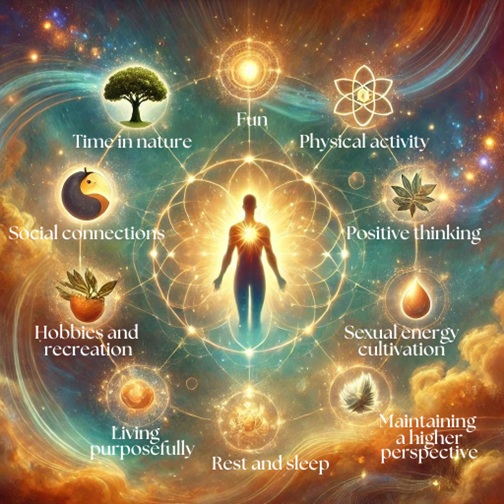
In summary, the key to maintaining and improving your energy levels lies in a combination of reducing energy drains and actively engaging in activities that recharge you. By making conscious choices and developing healthy habits, you can ensure that you have the vitality to lead a fulfilling and productive life.
Each day presents an opportunity to refine and amplify our energy. This course is designed to help you do just that — through direct, experiential practices that work with your energy body, empowering you to increase, balance, and sustain your energy levels.
Qigong is like ‘push-ups’ for your energy body.
2. Understanding the Energy Body
The concept of the energy body – also called the subtle body or etheric body – refers to the idea that we possess not only a physical body but also an energetic counterpart that influences our health, emotions, and overall vitality.
You may be familiar with the old anatomy books that were a series of transparencies for the different systems in the body. All the transparencies were laid on top of each other, forming the whole physical anatomy. Then you began to strip away the layers. First you removed the transparency that contained the skin, then you lifted the transparency that contained the muscles, ligaments and tendons, then there was the transparency that contained the blood vessels… and so on, until the last transparency was lifted and there was nothing left on the page.
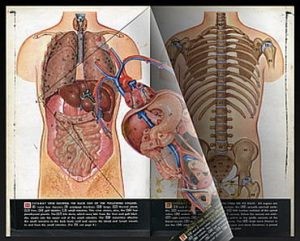
The idea of an energy body is that there is another set of transparencies present after the last transparency relating to the physical body has been lifted.
Essentially, there is a hidden architecture within the body that exists beneath what the naked eye can see. This is what is called our ‘energy anatomy’.
The different traditions that describe the energy anatomy do so with remarkable consistency, but also noticeable differences that reflect the unique vantage point of that tradition.
Each of the traditions describe centres of power linked by pathways through which energy flows.
Let’s have a look at some of the traditions that describe the energy body:
Taoism
In the Taoist system, which is the basis for Traditional Chinese Medicine (TCM), the concept of the energy body is expressed through the flow of Qi (or chi) along meridians. Qi is the vital life force that sustains physical and mental activities. Meridians are channels that transport Qi throughout the body, maintaining balance and health. There are twelve primary meridians, each associated with specific organs and functions.
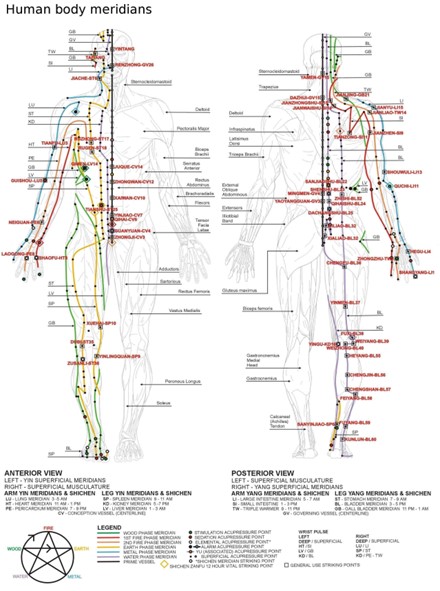
Chart by: By KVDP – Public Domain, https://commons.wikimedia.org/w/index.php?curid=8989443
TCM practices like acupuncture, acupressure, and Qigong aim to balance the flow of Qi, removing blockages and ensuring smooth energy circulation. This balance is crucial for physical health, emotional stability, and overall vitality.
Yoga
In Hindu philosophy and yoga, the concept of the energy body is well-established through the system of chakras and nadis.
Chakras are spinning wheels or vortices of energy located along the spine, each associated with different physical, emotional, and spiritual aspects of our being. There are seven primary chakras:
- Root Chakra (Muladhara): Located at the perineum, associated with survival and grounding.
- Sacral Chakra (Svadhisthana): Located at the sacral plexus, associated with creativity and sexuality.
- Navel Chakra (Manipura): Located at the navel, and including the solar plexus, associated with personal power and confidence.
- Heart Chakra (Anahata): Located in the chest, associated with love and compassion.
- Throat Chakra (Vishuddha): Located at the throat, associated with communication and expression.
- Third Eye Chakra (Ajna): Located between the eyebrows, associated with intuition and insight.
- Crown Chakra (Sahasrara): Located at the top of the head, associated with spiritual connection and enlightenment.
The nadis are energy channels through which prana (life force) flows, nourishing the body, mind, and spirit. Ancient texts state that there are 72,000 nadis branching throughout the body, forming a vast network that carries prana to different areas. While all nadis are important, three are considered the most significant in yogic practices: Ida, Pingala, and Sushumna.
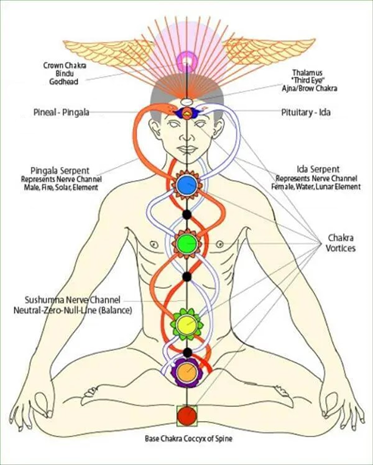
The Ida Nadi, also called the lunar energy channel, is associated with the left nostril and the right hemisphere of the brain. It represents cooling, feminine, introspective, and calming energy. Ida governs mental clarity, intuition, and relaxation. It is also associated with the parasympathetic nervous system, which according to modern physiology controls the relaxation response of the body.
The Pingala Nadi, or solar energy channel, is associated with the right nostril and the left hemisphere of the brain. It represents heating, masculine, dynamic, and active energy, corresponding to the sun. Pingala governs physical vitality, logical thinking, and outward expression. It is also associated with the sympathetic nervous system, which according to modern physiology controls the fight/flight (survival) response of the body.
The Sushumna Nadi, also known as the central channel, runs along the spinal column from the base at the Muladhara Chakra to the crown at the Sahasrara Chakra. It is considered the pathway of spiritual awakening, and is activated when ida and pingala are in balance. In other words, when the sympathetic nervous system and parasympathetic are equally active, and in balance, we enter a flow state in which higher faculties open.
Western Esoteric Traditions
In Western esoteric traditions, the energy body is often referred to as the aura or biofield. The aura is considered an electromagnetic field that surrounds and permeates the physical body, reflecting our physical, emotional, and spiritual states. It is composed of multiple layers, each corresponding to different aspects of our being:
- Physical Layer: Closest to the body, associated with physical health.
- Emotional Layer: Reflects emotional well-being.
- Mental Layer: Associated with thoughts and cognitive processes.
- Spiritual Layer: Represents the connection to higher consciousness and spiritual realms.
Practices like energy healing, therapeutic touch, and certain forms of meditation aim to cleanse and strengthen the aura, promoting overall health and wellbeing.

Indigenous Cultures
Many indigenous cultures also recognise the concept of an energy body, though the terminology and practices vary. For example:
- Native American Traditions: Often speak of spirit and vital energy in the context of holistic health, where rituals, ceremonies, and connection to nature play a crucial role in maintaining energetic balance.
- African Traditions: Concepts like ashe in Yoruba culture represent a life force that flows through all living things. Rituals, dance, and music are used to align and harmonise this energy.
- For further examples, see the document called “Comparison of Vital Energy Concepts Across Cultures” in the Exercise Files tab.
3. Functions of the Energy Body
The energy body serves several fundamental functions, each crucial for maintaining our health and vitality:
- Absorption of Energy: The energy body absorbs life force energy (Prana, Chi, or Qi) from the environment. This energy is essential for maintaining our physical vitality and overall wellbeing.
- Distribution of Energy: Once absorbed, this energy is distributed throughout the body via pathways (meridians, nadis, or energy channels). These pathways ensure that vital energy reaches all parts of the body, supporting physical and mental functions.
- Energy Storage: The energy body also acts as a reservoir, storing excess energy for future use. This stored energy can be drawn upon during times of physical exertion, stress, or illness, helping to sustain our strength and resilience.
- Healing and Restoration: The energy body facilitates healing by directing energy to areas that need repair or balance. Practices such as acupuncture, reiki, and Qigong work on the energy body to promote healing and restore harmony.
- Emotional and Mental Regulation: The energy body reflects and influences our emotional and mental states. Positive emotions and thoughts enhance the flow of energy, while negative emotions and stress can create blockages. Techniques like meditation and mindfulness help clear these blockages and maintain a balanced energy flow.
- Interactions with the Physical Body: The energy body is intricately connected to the physical body. When energy flows smoothly and freely, we experience optimal health, vitality, and emotional wellbeing. Conversely, disruptions or imbalances in the energy body can manifest as physical ailments, emotional distress, or mental unrest.
When we first begin working with the energy body, it is often in a dormant state or operating on a low charge. Much like an untrained muscle, the energy body may initially seem weak or underdeveloped, with only subtle sensations or faint energy flows detectable. This dormancy is a natural starting point, reflecting the body’s unused potential and its readiness for activation and growth. Think of the contrast between a muscle-bound weight lifter and a person who has never exercised. The same muscle form exists within the person who has never exercised, but it is there in a potential form only, and cannot be seen. For this reason, In Taoist terminology, the energy body is called an “immortal foetus”. It is a part of us that begins in an underdeveloped form, but what is developed survives past death. More on this later (in Lesson 5).
As we engage in practices designed to awaken and cultivate the energy body — such as Qigong, Tai chi, yoga, meditation, breathwork, etc. — we start to stimulate and expand its capacity. Initially, the changes might be subtle. We may begin to feel tingling sensations, warmth, or a gentle flow of energy in specific areas of the body. These early signs are indicators that the energy body is awakening, responding to our focused intention and practice.
With consistent practice, the potential of the energy body grows significantly. Regular engagement in energy work helps to clear blockages, enhance the flow of energy through the body’s channels, and increase the overall charge that the energy body can hold. This process is akin to building physical endurance or strength; over time, the energy body becomes more robust and resilient, capable of sustaining higher levels of energy.
As the energy body strengthens, its influence on our physical, emotional, and mental states becomes more pronounced. We experience heightened vitality, improved health, and a greater sense of emotional balance and mental clarity. The increased flow of energy leads to profound personal transformations, enhancing our ability to heal, to connect with others, and to achieve our goals. This growth is not only a testament to the power of the energy body but also a reflection of our inherent potential for self-improvement and holistic wellbeing.
Ultimately, the journey of working with the energy body is one of continuous evolution and expansion. As we deepen our practice and understanding, we unlock greater levels of energy and awareness, leading to a richer, more vibrant life. The once dormant or low-charge energy body transforms into a dynamic and potent force, driving us towards our highest potential and helping us to navigate the complexities of life with grace and power.
4. The Energy Body is an Interface Between Mind and Matter
The energy body is the medium zone between the opposite sides of the spectrum defined by spirit, on the one side, and physicality on the other. As such, the energy body serves as a vital interface between mind and matter, embodying elements of both realms and acting as a bridge that connects our physical existence with our mental and spiritual experiences.
Situated at the halfway point between pure spirit and tangible matter, the energy body is uniquely positioned to respond to and influence both domains.
It is of both natures, being both matter (in the sense that it has a certain physical manifestation, a rhythm, a pulse, a kind of magnetism) and spirit (unlimited potential). So, it can interact with both, affect and be affected by both.
Like mud is halfway between earth and water, it is both earthy and liquid, and yet quite unlike the other two.
This dual nature allows it to play a crucial role in our overall wellbeing, facilitating communication and interaction between our thoughts, emotions, and physical state. It carries messages from each pole to the other.
On one hand, the energy body draws from the ethereal and spiritual realms, absorbing and channelling the life force energy that permeates the universe. This energy is essential for maintaining our vitality and spiritual health. Through practices such as Qigong, Tai Chi, meditation and prayer, we can tap into this reservoir of spiritual energy, directing it through the energy body into the physical body to foster inner peace, spiritual growth, and healing. This spiritual energy not only revitalises the physical body but also nurtures the mind and soul, promoting a holistic sense of wellbeing.
Conversely, the energy body also interacts intimately with the physical realm. It influences and is influenced by our bodily functions and physical health. The network of energy channels that make up our subtle anatomy correspond to various physical organs and systems, and so reflect those systems. By directing energy through these pathways, the energy body can stimulate healing, enhance physical vitality, and regulate bodily processes. Physical practices like yoga, Tai Chi, and Qigong utilise this principle by promoting the flow of energy through the body, thus harmonising and balancing both physical and energetic states.
This dynamic interplay between the spiritual and physical aspects of our being underscores the profound significance of the energy body. It acts as a mediator that translates our spiritual intentions into physical realities and vice versa. For instance, positive thoughts and emotions can enhance the flow of energy through the body, promoting health and vitality. Conversely, physical practices and activities can influence our energy body, enhancing our spiritual awareness and mental clarity. Understanding and working with the energy body allows us to harness its potential to influence both our inner and outer worlds, leading to a more integrated and harmonious existence.
In essence, the energy body is a bridge that unites the mind, body, and spirit. By nurturing and balancing this vital interface, we can achieve greater harmony within ourselves and our environment. Through mindful practices and intentional living, we can harness the power of the energy body to enhance our physical health, emotional wellbeing, and spiritual growth, ultimately leading to a more fulfilling and vibrant life.
There is an echo here of the Hermetic tradition, which has as it’s end-goal what they call the “Spiritous Earth”. That the goal of our evolutionary impulse as human beings is to embody our Spirit, so that it can make a difference within the world of matter. To become, an agent for Spirit, so to speak. This occurs when the energy body is strong and dense, so that it can receive clearly the impulse of the spirit. So that Spirit guides matter.
As written in the Emerald Tablet (translated from the Chaldean by Sigismund Bacstrom):
The Secret Works of CHIRAM, one in essence, but three in aspect.
It is true, no lie, certain and to be depended upon, the superior agrees with the inferior, and the inferior agrees with the superior, to effect that one truly wonderful work.
As all things owe their existence to the will of the only one, so all things owe their origin to the one only thing, the most hidden by the arrangement of the only God.
The father of that one only thing is the sun its mother is the moon, the wind carries it in its belly; but its nurse is a spirituous earth.
That one only thing is the father of all things in the Universe.
Its power is perfect, after it has been united with a spirituous earth.
“That one only thing” is Qi, the unified field of energy, the substratum of all created things, the ‘implicate order’, as it is referred to in theoretical physics. The wind carries it in its belly – a reference to the fact that we breathe it in, and it is “nursed” by a spiritous earth – that is, as we cultivate it, we nurse it as it nurtures us. It’s power is perfect, after it has been united with a spiritous earth. Through the practice of Qigong, we infuse our material bodies – the matter within us – with the energy of the spirit, becoming ‘spiritous earth’, which is then capable of wielding this force ever more powerfully.
5. What is “Qi“?
Qi is often described as the vital life force or energy that that permeates the universe and flows through all living things. It is believed to be present in everything, from the air we breathe to the food we eat, and it circulates within the body along specific pathways.
In my understanding, I have come to understand it as the ‘pixelations of the universe’. The analogy is with how computer screens work. Just as how our computer screens are made up of tiny pixelations that change colour depending on what is shown on the screen, so too does the universe consist of countless tiny “pixels” of energy that constantly shift and interact to form the tapestry of existence.
The pixelation analogy is useful because it underscores the following key points:
- Building Blocks of Reality: Just as pixels combine to create the images we see on a screen, Qi forms the fundamental building blocks of reality. Every object, thought, and action is made up of these tiny particles of energy.
- Dynamic Interactions: Pixels on a screen change colour and intensity based on the data they receive, creating dynamic images. Similarly, Qi is in constant motion, influenced by internal and external factors, shaping the ever-changing landscape of our lives and the universe.
- Holistic Perception: When we view a computer screen, we see a complete picture rather than individual pixels. In the same way, while Qi operates on a microscopic level, its effects are holistic and manifest as the physical, emotional, and spiritual experiences we perceive.
Viewing Qi as ‘universal pixels’ also highlights the following implications:
- Interconnectedness: This analogy underscores the interconnectedness of all things. Just as each pixel is integral to the image on a screen, each particle of Qi is connected, contributing to the whole. Understanding this helps us see how our actions and energy influence the broader environment.
- Balance and Harmony: The quality of an image on a screen depends on the harmonious functioning of its pixels. Similarly, the quality of our lives depends on the balanced and harmonious flow of Qi. Practices that cultivate and balance Qi, such as meditation, Qigong and Tai Chi, and acupressure/acupuncture, help maintain this harmony.
- Continuous Transformation: The pixels on a screen are continually changing to display new images. Qi is also in perpetual flux, adapting and transforming in response to our thoughts, emotions, and interactions with the world. Embracing this constant change is key to living in harmony with the universal flow.
Seeing Qi as the pixelations of the universe provides a tangible way to understand this profound concept. It emphasises the intricate and interconnected nature of all existence, reminding us of the importance of maintaining balance and harmony in our lives. Just as each pixel contributes to the clarity and beauty of an image, every particle of Qi plays a crucial role in the Grand Harmony of life. By cultivating and harmonising our Qi, we can contribute to a more vibrant and balanced world.
6. The Relationship Between Thought and the Energy Body
Thought is able to guide the energy body because it is of a slightly denser nature.
Just as one needs to exert greater force than the weight of a physical object to move that object, the mind can summon sufficient focus and intent, through the power of thought, to influence the subtler aspects of the energy body.
In this way, thought serves as a powerful tool to direct and manipulate energy.

The relationship between thought and the energy body can be likened to the principle of leverage in the physical world. Just as a lever amplifies force to move a heavy object, focused thought can amplify and direct energy within the body. This process requires a clear intention and a concentrated mind, allowing the denser mental energy to interact with and guide the more subtle energies of the energy body.
By harnessing the power of thought, we can consciously influence the flow and distribution of energy throughout our energy body. Visualisation techniques, for instance, utilise this principle by directing mental imagery to shape and enhance the movement of energy. When we visualise energy flowing to a specific area, we effectively guide the energy body to respond and align with our mental directives. This focused intent can promote healing, balance, and vitality, demonstrating the profound interconnectedness between mind and matter.
In essence, the ability of thought to guide the energy body underscores the transformative potential of our mental faculties. Through disciplined practice and mindful focus, we can learn to wield our thoughts as instruments of change, directing the flow of energy to optimise our physical, emotional, and spiritual wellbeing. This dynamic interplay between thought and energy exemplifies the intricate dance between the denser and subtler aspects of our being, empowering us to create a harmonious and empowered existence.
7. A Sense of Empowerment
If we view ourselves as a physical being only, i.e. if we think that all we are is ‘blood and bone’, we limit our perception to the physical realm and constrain our potential.
By recognising that we are composed of and influenced by the subtle energy of Qi, we open ourselves to a deeper understanding of our true nature and capabilities.
This realisation brings a profound sense of empowerment, as we begin to see ourselves not just as physical beings, but as dynamic, energetic entities connected to the vast, intricate web of life.
This shift in perception opens up new possibilities for personal growth, creativity, connection and healing.
- Personal growth: Shifting our focus from merely the physical to include our energetic nature broadens our perspective. We become more attuned to the subtle forces at play within and around us, enhancing our awareness and intuition.
- Connection: Seeing ourselves as energetic beings fosters a deeper connection with others. We become more empathetic and compassionate, recognising that we are all part of the same energetic fabric. This sense of unity can strengthen relationships and build a more harmonious community.
- Healing: recognising the flow of Qi within our bodies as the fundamental determinant of health allows us to take charge of our wellbeing. As mentioned above, the energy body is the interface between mind and matter. There are trillions of cells in our body, which most of us are unable to interact with directly. However, the energy body as an interface allows us this control. Our thoughts can move our energy body and our energy body can influence our physical cells.
At this level of awareness, we gain the ability to actively participate in our own healing process.
Allow me to explain this further. Let’s take, for example, one metre of any piece of matter – let’s a stick or a carpet. Looking at the object from a short distance away, we see only 1 thing – a stick or a carpet. If we zoomed up into space and looked down, we wouldn’t see anything, but we know that it is there. Similarly, if we went up very close to the object, we would see more. If we divided that one-metre object into one thousand equal parts, and investigated every part through a microscope, we would see an intricate structure composed of countless smaller components. Going deeper, if we then divided one of those parts into a further thousand parts, we would see the molecular structure of the material. This intricate pattern of molecules forms the basis of the stick or carpet’s physical properties. This is the level that modern science interacts with the body – through the use of chemicals, modern medicine affects these molecules, causing them to change in ways that promote healing or alleviate symptoms.
However, there are deeper layers. Zooming in further, we would see the atoms that constitute these molecules – atoms composed of protons, neutrons, and electrons. Beyond that, we find subatomic particles and quantum fields. These subatomic particles interact through fundamental forces that govern the behaviour of matter at the smallest scales.
This deeper level of reality is where the concept of Qi, and ‘energy medicine’, comes into play. At this layer, there is no need to give names to diseases (these names belong to a higher echelon of the ladder). Instead, the focus is on the flow and balance of energy.
When we work with Qi, this is the layer of the reality ladder that we are working with. So, even though very few of us are able to interact directly with our ‘blood and bone’, we can influence our physical health by working with the energy that underlies and permeates these physical structures.
This gives us a sense of empowerment. We are no longer just “end-users” of our bodies, but rather active participants in our own health and wellbeing.
Pain and disease is where the energy is blocked. We feel into those areas, bringing our awareness and intention to them. By focusing on these regions, we can start to sense the underlying energetic imbalances causing the physical symptoms. Through understanding the principles of working with energy, and learning techniques to cleanse the meridians and strengthen Qi, we can release these blockages and restore the natural flow of Qi, which then translates into radiant health.
8. Our Different ‘Bodies’
In Taoism there is the concept of our different bodies: the physical body, the emotional body, the mental body, the energy body and the spirit. These are the different aspects of our experience.
Of all of these, the insight of the Taoist masters was that only the physical body is limited in time and space.
The emotional body is not limited in time or space because we can feel just as much for a person in the same room as ourselves as a person across another side of the world or in the history of the world. The mental body is not limited in time or space because we can think just as easily of something or someone in the present, past or future as we can in any location. The Spirit body is also unlimited in time and space, as the most unlimited part of ourselves.
The result is, therefore, that the majority of our components are unlimited in time or space. We can utilise that to power up the physical body.
Following this insight, the idea of Taoist exercise was to bring the power of the spirit through into a thought, which is an imagining, so that then it becomes a feeling, and then enters the physical body as a power or strength.
To ‘play with the energy body’ means feeding it images and seeing how it responds. If you feed it terrible imaginings, as in the case of worry and anxiety, it responds with angst and trepidation. If you feed it powerful imaginings, it feels strong.
If you feed it smiles, it will beam back at you. (That’s the foundational Taoist exercise, which is discussed in more detail in Lesson 7.)
The energy body develops in strength and power through these exercises.
As mentioned above, at first the energy body may hold only a very small charge, but with dedication and concentration, it gradually becomes more robust and capable of storing and directing greater amounts of energy.
Through dedicated practice and concentration, the energy body evolves from holding a small charge to becoming a powerful reservoir of energy.
9. Achieving Mastery
Mastery in energy work is a progressive deepening of awareness, refinement of skill, and alignment with the natural flow of Qi and the Grand Harmony.
As practitioners advance, they develop greater sensitivity, control, and integration of their internal energies, leading to profound physical, mental, and spiritual benefits. Achieving mastery requires patience, dedication, and an openness to continuous learning. The following key aspects define this journey:
- Increased Sensitivity: Mastery involves a heightened sensitivity to energy, allowing practitioners to detect and manipulate subtle energies with greater precision.
- Balancing Energies: Advanced practitioners learn to balance their internal energies, ensuring that the flow of energy remains harmonious and free from blockages.
- Healing Abilities: With a well-developed energy body, individuals can use their energy for healing themselves and others. This involves directing energy to areas of imbalance, and assisting in the removal of energy blockages.
- Spiritual Growth: A strong and balanced energy body is essential for spiritual growth. It supports deeper meditation, enhanced intuition, and a greater connection to higher states of consciousness.
